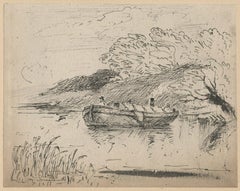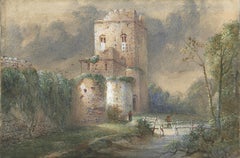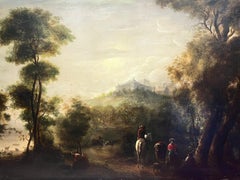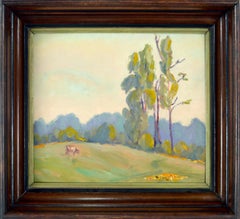David Hassell
1810s Romantic Landscape Drawings and Watercolors
Ink
1840s Romantic Landscape Drawings and Watercolors
Watercolor
People Also Browsed
18th Century Old Masters Landscape Paintings
Oil
Early 20th Century Post-Impressionist Landscape Paintings
Oil, Illustration Board
Early 20th Century American Impressionist Landscape Paintings
Oil, Canvas, Cardboard
1880s English School Landscape Paintings
Canvas, Oil
1920s American Impressionist Landscape Paintings
Linen, Oil
1980s Pop Art Landscape Paintings
Mixed Media
1860s Victorian Landscape Paintings
Oil
Early 20th Century Realist Figurative Prints
Etching
1880s Victorian Landscape Paintings
Canvas, Oil
1980s Contemporary Landscape Paintings
Canvas, Oil
1970s Abstract Expressionist Landscape Paintings
Paper, Ink
2010s Contemporary Figurative Paintings
Oil
Early 20th Century Victorian Landscape Paintings
Oil
1940s Impressionist Landscape Paintings
Canvas, Oil
Early 20th Century Art Nouveau Landscape Paintings
Gold Leaf
1870s Realist Animal Paintings
Oil, Wood Panel
David Cox for sale on 1stDibs
David Cox was born at Deritend, near Birmingham, in 1783, as a son of a blacksmith. In around 1798, aged 15, he was apprenticed to a miniature painter named Fieldler. Following Fieldler's suicide, Cox was apprenticed around 1800 as an assistant to a theatre scene-painter named De Maria. In 1804, he took work as a scene-painter with Astley's Theatre and moved to London. By 1808, Cox had abandoned scene-painting, taking water-color lessons with John Varley. In 1805, he made the first of his many trips to Wales, with Charles Barber; his earliest dated watercolors are from this year. Throughout his lifetime, he made numerous sketching tours to the home counties, North Wales, Yorkshire, Derbyshire and Devon. Cox exhibited regularly at the Royal Academy from 1805. His pictures never sold for high prices, and he earned his living chiefly as a drawing-master. Through his first pupil, Col. the Hon. H. Windsor (the future Earl of Plymouth), who engaged him in 1808, Cox acquired several other aristocratic pupils. He wrote several books, including Ackermann's New Drawing Book (1809); A Series of Progressive Lessons (1811); Treatise on Landscape Painting (1813) and Progressive Lessons on Landscape (1816). The ninth and last edition of his Series of Progressive Lessons was published in 1845. In 1810, he was elected President of the Associated Artists in Watercolor. In 1812, following the demise of the Associated Artists, he was elected an Associate of the Society of Painters in Watercolor (Old Watercolor Society). Cox was elected a Member of the Society in 1813, and exhibited there every year except 1815 and 1817, until his death. In about 1814–15, he was appointed drawing-master at the Military Staff College, Farnham. With his appointment as drawing-master at Miss Croucher's girls' school, he took up residence in Hereford. He made his first trip to the Continent, to Belgium and Holland, in 1826 and moved to London the following year. He exhibited for the first time with the Birmingham Society of Artists in 1829, and with the Liverpool Academy from 1831. In 1839, two of Cox's watercolors were bought from the Old Watercolor Society exhibition by the Marquis of Conyngham for Queen Victoria. Around 1840, Cox took up oil painting, studying under W.J. Müller (1812–45). Cox exhibited two oil paintings at the Royal Academy in 1844. From 1844–56, he spent summers at Betws-y-Coed, in North Wales. His health suffered following a stroke in 1853. In 1855, he was represented by watercolors at the Paris Universal Exhibition. By 1857, however, his eyesight had deteriorated. An exhibition of his work was arranged in 1858 by the Conversazione Society, Hampstead, and in 1859 a retrospective exhibition was held at the German Gallery, Bond Street, London. Cox died several months later. He was buried in Harborne, near Birmingham, where he had retired in 1841.
A Close Look at romantic Art
In emphasizing emotion and imagination, romantic art shifted away from the restraint of classicism and neoclassicism that had dominated art in Europe since the Renaissance. Romanticism achieved its greatest popularity in art, literature, music and philosophy between 1780 and 1830, although its expression of individual experiences ranging from awe to passion informed culture in the decades after.
Landscape painting was especially popular during the romantic period, as were nature studies of wild animals and fantasies of exotic lands. Romanticism varied across Europe as it reacted to the rise of industrialization, a more personal relationship with faith that was distanced from the church and the rationalist thinking of the Enlightenment.
British painters such as John Constable and J.M.W. Turner responded dramatically to the light and atmosphere of the natural world, while William Blake conveyed humanity’s connection to the divine in his visionary art. In Germany, the late-18th-century Sturm und Drang, or Storm and Drive, movement, with its probing of the unconscious, inspired a sense of mystery in work by romantic artists such as Caspar David Friedrich and Philipp Otto Runge. In France, where the French Revolution had turned tradition upside down, Théodore Géricault and Eugène Delacroix used lush brushwork to paint monumental canvases with tumultuous scenes of nature and history.
The romantic movement and its subject matter were a significant influence on the Pre-Raphaelites, Symbolists and the American painters of the Hudson River School, as well as on other cultural movements in the 19th and 20th centuries that saw artists build on this perspective in which art was guided by emotion rather than reason.
Find a collection of romantic paintings, sculptures, prints and multiples and more art on 1stDibs.
Finding the Right landscape-drawings-watercolors for You
Landscape drawings and watercolors show the world through the lenses of different cultures and perspectives. They were also incredibly important for displaying natural scenes before the invention of photography.
There are many ways to effectively arrange art on your walls so that you’re maximizing your wall space. You can introduce peace and serenity within the confines of a living room or bedroom if landscape drawings and watercolors are part of the art that you choose to bring into a space.
Watercolor landscapes have a rich history dating back to ancient China, where they dominated painting genres by the late Tang dynasty. Ink-on-silk paintings in China featured mountains and large bodies of water as far back as the third century. The Netherlands was home to landscapes as a major theme in painting as early as the 1500s, and by the Renaissance, watercolors had made their way to the West and into European culture, becoming a staple of decorative art.
It wasn’t until the Industrial Revolution that watercolor paints became more widely available and embedded in fine arts. Despite their broad distribution today, some artists have chosen to revive the old craft of preparing their own watercolor pigments, paying homage to the medium’s roots.
The variety of brush combinations and painting methods makes watercolor landscapes some of the most stunning pieces in any collection. Find landscape drawings and watercolors on 1stDibs.



